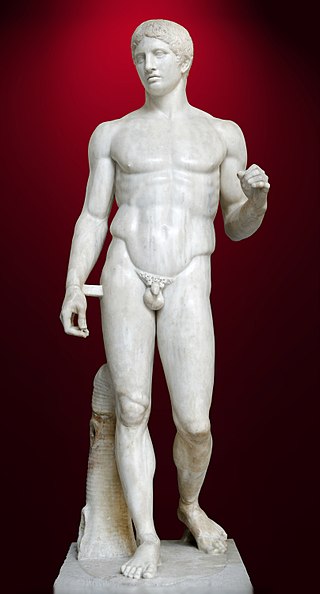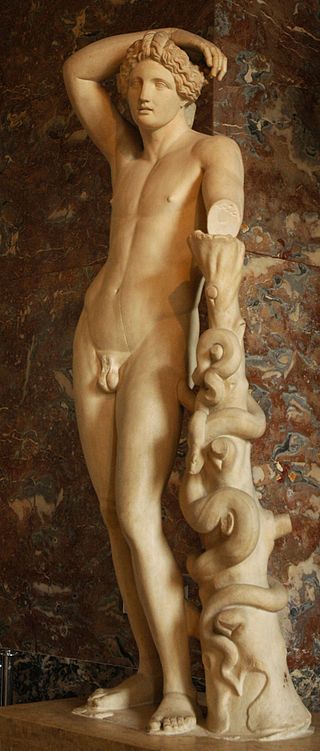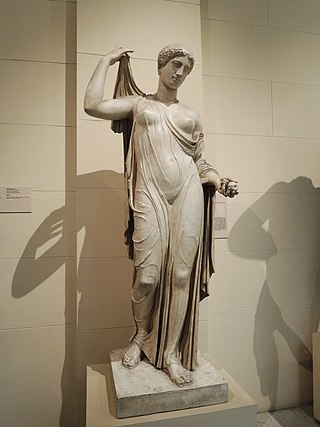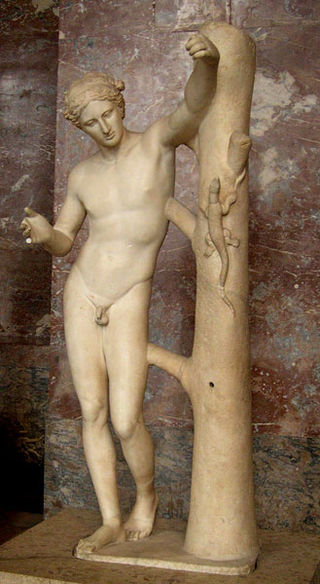
The Mausoleum at Halicarnassus or Tomb of Mausolus was a tomb built between 353 and 350 BC in Halicarnassus for Mausolus, an Anatolian from Caria and a satrap in the Achaemenid Empire, and his sister-wife Artemisia II of Caria. The structure was designed by the Greek architects Satyros and Pythius of Priene. Its elevated tomb structure is derived from the tombs of neighbouring Lycia, a territory Mausolus had invaded and annexed c. 360 BC, such as the Nereid Monument.

Phidias or Pheidias was an Ancient Greek sculptor, painter, and architect, active in the 5th century BC. His Statue of Zeus at Olympia was one of the Seven Wonders of the Ancient World. Phidias also designed the statues of the goddess Athena on the Athenian Acropolis, namely the Athena Parthenos inside the Parthenon, and the Athena Promachos, a colossal bronze which stood between it and the Propylaea, a monumental gateway that served as the entrance to the Acropolis in Athens. Phidias was the son of Charmides of Athens. The ancients believed that his masters were Hegias and Ageladas.

Praxiteles of Athens, the son of Cephisodotus the Elder, was the most renowned of the Attica sculptors of the 4th century BC. He was the first to sculpt the nude female form in a life-size statue. While no indubitably attributable sculpture by Praxiteles is extant, numerous copies of his works have survived; several authors, including Pliny the Elder, wrote of his works; and coins engraved with silhouettes of his various famous statuary types from the period still exist.
Myron of Eleutherae, working c. 480–440 BC, was an Athenian sculptor from the mid-5th century BC. He was born in Eleutherae on the borders of Boeotia and Attica. According to Pliny's Natural History, Ageladas of Argos was his teacher.

The statue of Athena Parthenos was a monumental chryselephantine sculpture of the goddess Athena. Attributed to Phidias and dated to the mid-fifth century BCE, it was an offering from the city of Athens to Athena, its tutelary deity. The naos of the Parthenon on the acropolis of Athens was designed exclusively to accommodate it.

Polykleitos was an ancient Greek sculptor, active in the 5th century BCE. Alongside the Athenian sculptors Pheidias, Myron and Praxiteles, he is considered as one of the most important sculptors of classical antiquity. The 4th century BCE catalogue attributed to Xenocrates, which was Pliny's guide in matters of art, ranked him between Pheidias and Myron. He is particularly known for his lost treatise, the Canon of Polykleitos, which set out his mathematical basis of an idealised male body shape.

The statue of Laocoön and His Sons, also called the Laocoön Group, has been one of the most famous ancient sculptures since it was excavated in Rome in 1506 and put on public display in the Vatican Museums, where it remains today. The statue is very likely the same one that was praised in the highest terms by Pliny the Elder, the main Roman writer on art. The figures in the statue are nearly life-sized, with the entire group measuring just over 2 m in height. The sculpture depicts the Trojan priest Laocoön and his sons Antiphantes and Thymbraeus being attacked by sea serpents.

The Apollo Lyceus type, also known as Lycean Apollo, originating with Praxiteles and known from many full-size statue and figurine copies as well as from 1st century BCE Athenian coinage, is a statue type of Apollo showing the god resting on a support, his right forearm touching the top of his head and his hair fixed in braids on the top of a head in a haircut typical of childhood. It is called "Lycean" not after Lycia itself, but after its identification with a lost work described, though not attributed to a sculptor, by Lucian as being on show in the Lyceum, one of the gymnasia of Athens. According to Lucian, the god leaning on a support with his bow in his left hand and his right resting on his head is shown "as if resting after long effort." Its main exemplar is the Apollino in Florence or Apollo Medici, in the Uffizi, Florence.

Lysippos was a Greek sculptor of the 4th century BC. Together with Scopas and Praxiteles, he is considered one of the three greatest sculptors of the Classical Greek era, bringing transition into the Hellenistic period. Problems confront the study of Lysippos because of the difficulty of identifying his style among the copies which survive. Not only did he have a large workshop and many disciples in his immediate circle, but there is understood to have been a market for replicas of his work, supplied from outside his circle, both in his lifetime and later in the Hellenistic and Roman periods. The Victorious Youth or Getty bronze, which resurfaced around 1972, has been associated with him.

The sculpture of ancient Greece is the main surviving type of fine ancient Greek art as, with the exception of painted ancient Greek pottery, almost no ancient Greek painting survives. Modern scholarship identifies three major stages in monumental sculpture in bronze and stone: the Archaic, Classical (480–323) and Hellenistic. At all periods there were great numbers of Greek terracotta figurines and small sculptures in metal and other materials.

Gortyna was a town of ancient Crete which appears in the Homeric poems under the form of Γορτύν; but afterwards became usually Gortyna (Γόρτυνα). According to Stephanus of Byzantium it was originally called Larissa (Λάρισσα) and Cremnia or Kremnia (Κρήμνια).

Callimachus was an architect and sculptor working in the second half of the 5th century BC in the manner established by Polyclitus. He was credited with work in both Athens and Corinth and was probably from one of the two cities. According to Vitruvius (iv.1), for his great ingenuity and taste the Athenians dubbed Callimachus katatêxitechnos. His reputation in the 2nd century AD was reported in an aside by Pausanias as one "although not of the first rank of artists, was yet of unparalleled cleverness, so that he was the first to drill holes through stones"—that is, in order to enhance surface effects of light and shade in locks of hair, foliage and other details. Thus it is reported that Callimachus was known for his penchant for elaborately detailed sculptures or drapery, though few securely attributed works by him survive.

Classical sculpture refers generally to sculpture from Ancient Greece and Ancient Rome, as well as the Hellenized and Romanized civilizations under their rule or influence, from about 500 BC to around 200 AD. It may also refer more precisely a period within Ancient Greek sculpture from around 500 BC to the onset of the Hellenistic style around 323 BC, in this case usually given a capital "C". The term "classical" is also widely used for a stylistic tendency in later sculpture, not restricted to works in a Neoclassical or classical style.

The Antikythera Ephebe, registered as: Bronze statue of a youth in the museum collections, is a bronze statue of a young man of languorous grace that was found in 1900 by sponge-divers in the area of the ancient Antikythera shipwreck off the island of Antikythera, Greece. It was the first of the series of Greek bronze sculptures that the Aegean and Mediterranean yielded up in the twentieth century which have fundamentally altered the modern view of ancient Greek sculpture. The wreck site, which is dated about 70–60 BC, also yielded the Antikythera mechanism, a characterful head of a Stoic philosopher, and a hoard of coins. The coins included a disproportionate quantity of Pergamene cistophoric tetradrachms and Ephesian coins, leading scholars to surmise that it had begun its journey on the Ionian coast, perhaps at Ephesus; none of its recovered cargo has been identified as from mainland Greece.
Calamis was a Greek sculptor. One of his pupils was Praxias.

Apollo Sauroktonos is the title of several 1st – 2nd century AD Roman marble copies of an original by the ancient Greek sculptor Praxiteles. The statues depict a nude adolescent Apollo about to catch a lizard climbing up a tree. Copies are included in the collections of the Louvre Museum, the Vatican Museums, and the National Museums Liverpool.
Alexikakos, the "averter of evil", was an epithet given by the ancient Greeks to several deities such as Zeus and Apollo, who was worshipped under this name by the Athenians, because he was believed to have stopped the plague which raged at Athens in the time of the Peloponnesian War. It was also applied to Heracles.

Bacchanal: A Faun Teased by Children is a marble sculpture by Italian artists Gian Lorenzo Bernini and his father Pietro Bernini. It was executed in 1616 and 1617, when Gian Lorenzo was not yet twenty years old. It is currently in the Metropolitan Museum of Art in New York.

Ancient Greek art stands out among that of other ancient cultures for its development of naturalistic but idealized depictions of the human body, in which largely nude male figures were generally the focus of innovation. The rate of stylistic development between about 750 and 300 BC was remarkable by ancient standards, and in surviving works is best seen in sculpture. There were important innovations in painting, which have to be essentially reconstructed due to the lack of original survivals of quality, other than the distinct field of painted pottery.
The Cleveland Apollo is a 4th-century BCE life-size bronze statue, now in the Cleveland Museum of Art. It has acquired it in 2004 using the Severance and Greta Millikin Purchase Fund. Technical features of the Cleveland Apollo are consistent with the Late Classical Period, during Praxiteles's lifetime. The Museum attributed the piece to Praxiteles. Scientific investigation of the sculpture and the separated parts shows that they are from the same casting. The age of the casting is still under review as of 2017. Scholarly investigation has raised several questions about it being a Praxiteles original.
















